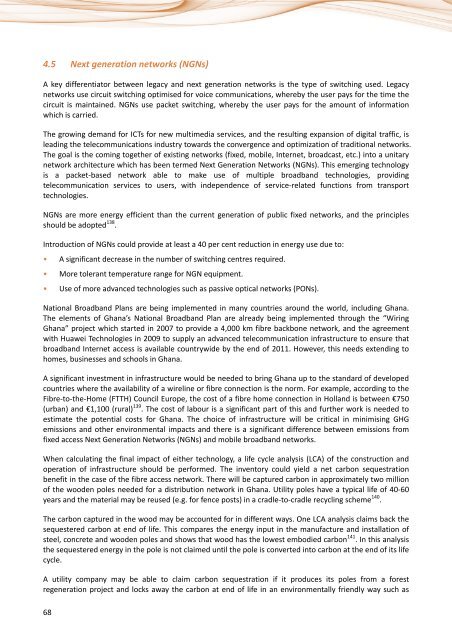Information and communication technologies (ICTs) and ... - ITU
Information and communication technologies (ICTs) and ... - ITU
Information and communication technologies (ICTs) and ... - ITU
Create successful ePaper yourself
Turn your PDF publications into a flip-book with our unique Google optimized e-Paper software.
4.5 Next generation networks (NGNs)<br />
A key differentiator between legacy <strong>and</strong> next generation networks is the type of switching used. Legacy<br />
networks use circuit switching optimised for voice <strong>communication</strong>s, whereby the user pays for the time the<br />
circuit is maintained. NGNs use packet switching, whereby the user pays for the amount of information<br />
which is carried.<br />
The growing dem<strong>and</strong> for <strong>ICTs</strong> for new multimedia services, <strong>and</strong> the resulting expansion of digital traffic, is<br />
leading the tele<strong>communication</strong>s industry towards the convergence <strong>and</strong> optimization of traditional networks.<br />
The goal is the coming together of existing networks (fixed, mobile, Internet, broadcast, etc.) into a unitary<br />
network architecture which has been termed Next Generation Networks (NGNs). This emerging technology<br />
is a packet-based network able to make use of multiple broadb<strong>and</strong> <strong>technologies</strong>, providing<br />
tele<strong>communication</strong> services to users, with independence of service-related functions from transport<br />
<strong>technologies</strong>.<br />
NGNs are more energy efficient than the current generation of public fixed networks, <strong>and</strong> the principles<br />
should be adopted 138 .<br />
Introduction of NGNs could provide at least a 40 per cent reduction in energy use due to:<br />
• A significant decrease in the number of switching centres required.<br />
• More tolerant temperature range for NGN equipment.<br />
• Use of more advanced <strong>technologies</strong> such as passive optical networks (PONs).<br />
National Broadb<strong>and</strong> Plans are being implemented in many countries around the world, including Ghana.<br />
The elements of Ghana’s National Broadb<strong>and</strong> Plan are already being implemented through the “Wiring<br />
Ghana” project which started in 2007 to provide a 4,000 km fibre backbone network, <strong>and</strong> the agreement<br />
with Huawei Technologies in 2009 to supply an advanced tele<strong>communication</strong> infrastructure to ensure that<br />
broadb<strong>and</strong> Internet access is available countrywide by the end of 2011. However, this needs extending to<br />
homes, businesses <strong>and</strong> schools in Ghana.<br />
A significant investment in infrastructure would be needed to bring Ghana up to the st<strong>and</strong>ard of developed<br />
countries where the availability of a wireline or fibre connection is the norm. For example, according to the<br />
Fibre-to-the-Home (FTTH) Council Europe, the cost of a fibre home connection in Holl<strong>and</strong> is between €750<br />
(urban) <strong>and</strong> €1,100 (rural) 139 . The cost of labour is a significant part of this <strong>and</strong> further work is needed to<br />
estimate the potential costs for Ghana. The choice of infrastructure will be critical in minimising GHG<br />
emissions <strong>and</strong> other environmental impacts <strong>and</strong> there is a significant difference between emissions from<br />
fixed access Next Generation Networks (NGNs) <strong>and</strong> mobile broadb<strong>and</strong> networks.<br />
When calculating the final impact of either technology, a life cycle analysis (LCA) of the construction <strong>and</strong><br />
operation of infrastructure should be performed. The inventory could yield a net carbon sequestration<br />
benefit in the case of the fibre access network. There will be captured carbon in approximately two million<br />
of the wooden poles needed for a distribution network in Ghana. Utility poles have a typical life of 40-60<br />
years <strong>and</strong> the material may be reused (e.g. for fence posts) in a cradle-to-cradle recycling scheme 140 .<br />
The carbon captured in the wood may be accounted for in different ways. One LCA analysis claims back the<br />
sequestered carbon at end of life. This compares the energy input in the manufacture <strong>and</strong> installation of<br />
steel, concrete <strong>and</strong> wooden poles <strong>and</strong> shows that wood has the lowest embodied carbon 141 . In this analysis<br />
the sequestered energy in the pole is not claimed until the pole is converted into carbon at the end of its life<br />
cycle.<br />
A utility company may be able to claim carbon sequestration if it produces its poles from a forest<br />
regeneration project <strong>and</strong> locks away the carbon at end of life in an environmentally friendly way such as<br />
68

















